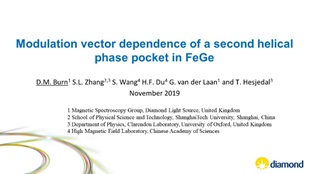
Modulation vector dependence of a second helical phase pocket in FeGe
D.M. Burn, S.L. Zhang, S. Wang, H.F. Du, G. van der Laan, and T. Hesjedal
Magnetism and Magnetic Materials Las Vegas, NV Nov 2019
FeGe is a noncentrosymmetric helimagnet in which non-collinear spin textures result from a competition between the exchange interaction and the spin-orbit-induced Dzyaloshinskii-Moriya interaction. Below the ordering temperature, Tc, bulk FeGe has a well-established and rich magnetic phase diagram showing helical, conical, and skyrmion states [1]. The skyrmion pocket has a wide temperature-field window extending up to room temperature [2,3] which can be manipulated through changes to the sample thickness [2,4]. These features make FeGe of great interest due to the potential for novel room-temperature technological devices based on the manipulation of topological magnetic states.
In this work, we characterize the magnetic states in a thin slab of FeGe with smallangle soft x-ray scattering on beamline I10 at the Diamond Light Source as a function of both temperature and magnetic field applied out-of-plane. In addition to the helical, conical, and skyrmion phases, we observe an additional helical phase which coexists beneath the skyrmion phase towards the higher field boundary of the helical phase. In contrast to the other phases this additional helical phase shows strong uniaxial preferential alignment of the modulation vector.
We have also explored the variation in the magnitude of the modulation vector when traversing each of the magnetic phase pockets. For the helical and conical phases, this shows a field-dependent but temperature-independent variation, whereas for the skyrmion phase both a field and temperature variation is observed. Furthermore, the two helical phases show significantly different coefficients for the field-dependent modulation vector contraction.
Our findings build on other work for FeGe, strengthening the case that the room-temperature topological magnetic properties are of great interest for the development of novel technological devices. Our work shows how multiple coexistent phases can be simultaneously and uniquely identified which will provide further opportunities for potential information processing and storage methodologies.
- [1] A. Bauer and C. Pfleiderer, Springer Series in Materials Science 228, 1 (2016).
- [2] X. Z. Yu, N. Kanazawa, Y. Onose, K. Kimoto, W. Z. Zhang, S. Ishiwata, Y. Matsui, and Y. Tokura, Nat. Mater. 10, 106 (2011).
- [3] H. Wilhelm, M. Baenitz, M. Schmidt, C. Naylor, R. Lortz, U. K. Robler, A. A. Leonov, and A. N. Bogdanov, J. Phys.: Condens. Matter 24, 294204(2012).
- [4] S. X. Huang and C. L. Chien, Phys. Rev. Lett. 108, 267201 (2012).